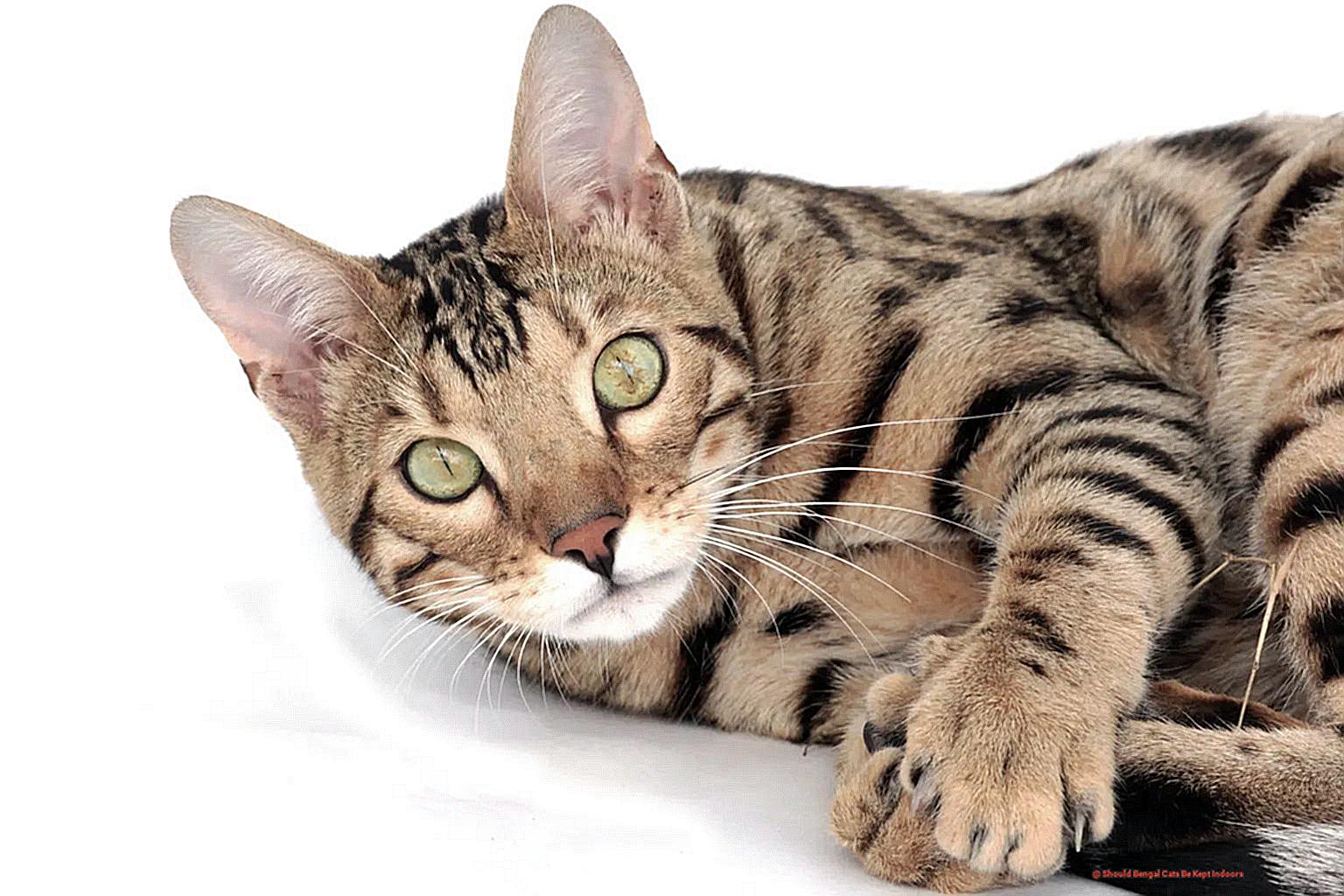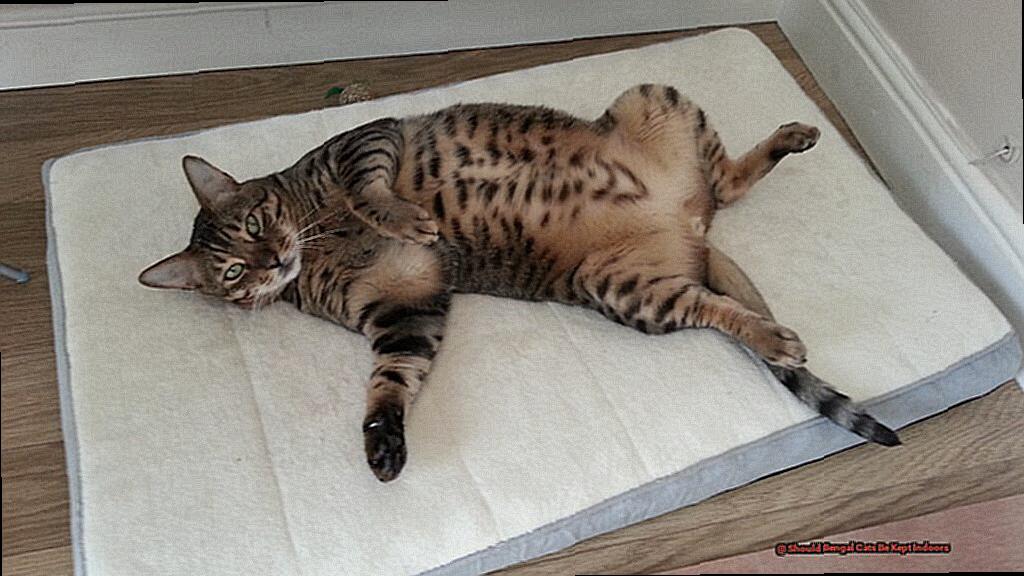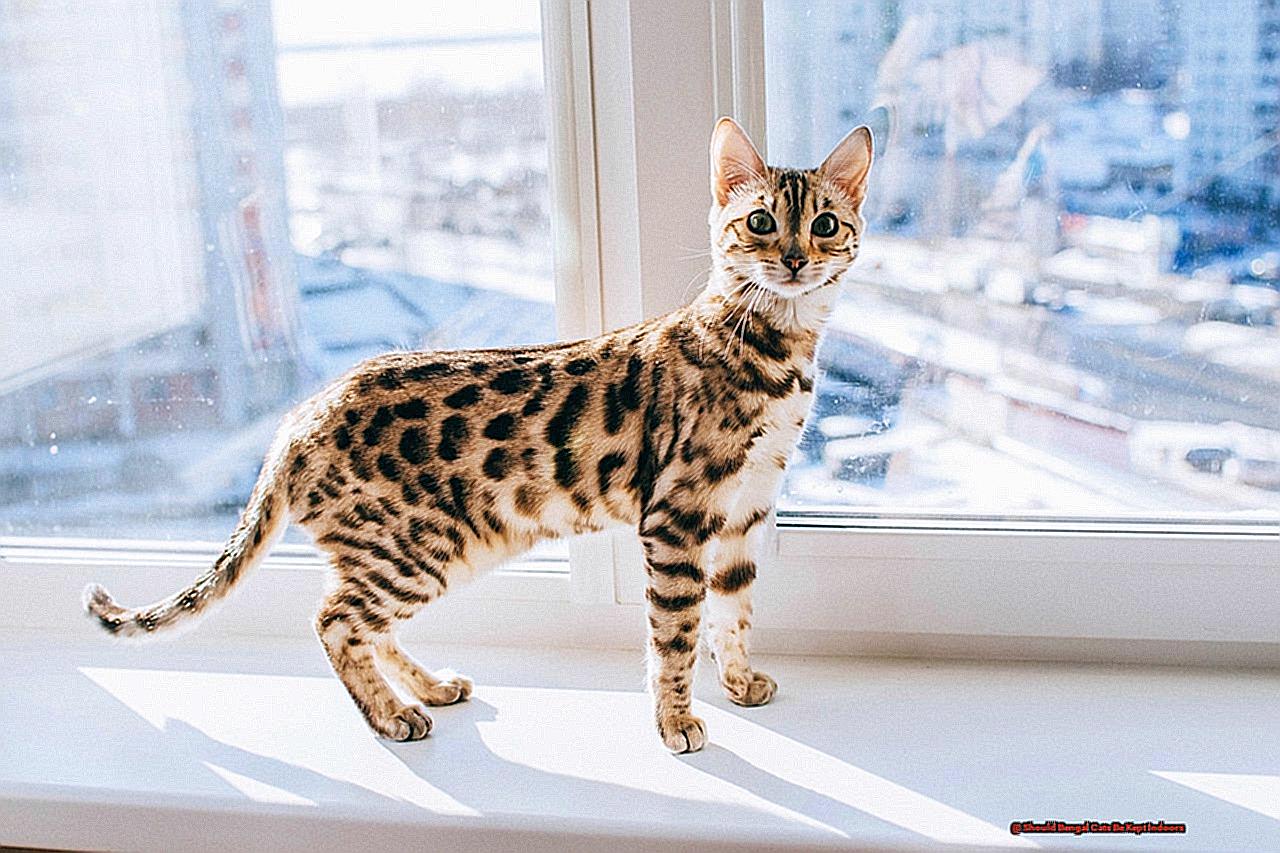You’re thinking about bringing a Bengal cat into your life, huh? Well, buckle up because you’ve got some decisions to make.
One of the big ones is whether to let your Bengal roam the great outdoors or keep them confined indoors. These cats are no ordinary felines – they’ve got looks that could rival a supermodel and enough energy to power a small city.
But what’s the best way to keep them safe and satisfied? In this blog post, we’re diving deep into the pros and cons of keeping Bengal cats indoors.
We’ll explore why creating a controlled and protected environment might be the purrfect choice for these wild-at-heart creatures. But hold on tight, because we’ll also uncover some potential downsides of confining these curious and active kitties.
Whether you’re already a proud Bengal owner or just curious about their indoor lifestyles, get ready for an adventure as we unravel the secrets to keeping these beautiful beasts happy and content in the comfort of your home.

Should Bengal cats be kept indoors
Bengal cats are a unique and captivating breed known for their wild appearance and energetic nature. As a Bengal cat expert, I often receive questions about whether these felines should be kept indoors or allowed outside to roam freely. In this article, we will delve into the pros and cons of keeping Bengal cats indoors, providing you with valuable insights to help you make an informed decision.
Pros of Keeping Bengal Cats Indoors:
Safety first:
- Traffic accidents, exposure to diseases, predation by other animals, and theft are all risks that outdoor cats face.
- Keeping Bengal cats indoors ensures their safety and protects them from harm.
Good neighbor relations:
- Bengal cats are highly energetic and curious creatures, which can sometimes lead to destructive behavior or excessive noise if they roam unsupervised.
- By keeping them indoors, you prevent potential nuisances to your neighbors and damage to neighboring properties.
Protecting the ecosystem:
- Bengal cats have retained their wild instincts, making them efficient hunters.
- Allowing them outdoors can disrupt the local ecosystem by killing small wildlife such as birds and rodents.
Cons of Keeping Bengal Cats Indoors:
Boredom and behavioral issues:
- Bengal cats are highly active and intelligent animals that require mental stimulation and physical exercise to thrive.
- Without access to the outdoors, they may become restless or develop behavioral problems such as aggression or excessive scratching.
Compromise for outdoor stimulation:
- Many cat owners strike a balance by providing supervised outdoor time in secure enclosures or leash training for controlled walks.
- This compromise allows Bengal cats to satisfy their natural instincts while still ensuring their safety.
What Are the Benefits of Keeping Bengal Cats Indoors?
When it comes to our beloved Bengal cats, their safety should be our utmost priority. Unlike other domestic cats, Bengals possess a strong instinct for exploration and hunting, making them prone to various dangers when left to roam freely outdoors. By keeping them indoors, we can protect them from traffic accidents, attacks by other animals, exposure to diseases, and the possibility of getting lost. It’s like having a cozy fortress where they can feel safe and secure.
Protecting Precious Wildlife
Bengal cats, with their wild ancestry, have a natural hunting instinct that can pose a threat to local wildlife if permitted outdoors. With their exceptional agility and athleticism, they become efficient hunters and may prey on birds, small mammals, and reptiles in the surrounding area. By keeping them indoors, we can minimize the impact on local ecosystems and preserve the delicate balance of wildlife populations. It’s a win-win situation for both our furry friends and our feathered neighbors.
Health and Happiness Matters
Outdoor cats are more susceptible to injury or illness due to exposure to hazardous chemicals, plants, and toxic substances present in the environment. Additionally, they face a higher risk of contracting infectious diseases from other animals or parasites such as ticks and fleas.
By keeping Bengal cats indoors, we can provide them with a healthier environment that minimizes these risks, ensuring their well-being.
Peaceful Living Environment
Bengal cats are known for their strong territorial instincts. When allowed outdoors, they may engage in territorial disputes with other cats or animals in the neighborhood. These conflicts can lead to injuries for the cat as well as costly veterinary bills for their owners. By keeping Bengals indoors, we eliminate the risk of such confrontations and maintain a peaceful living environment for both the cat and its human family.
Preventing Boredom and Nuisance Behaviors
Bengal cats are highly active and energetic creatures that require mental and physical stimulation to prevent boredom and frustration. When confined indoors, owners have more control over providing appropriate outlets for their cat’s energy. Interactive toys, scratching posts, and climbing structures can keep them entertained and prevent destructive behaviors like scratching furniture or excessive meowing. It’s all about keeping our Bengal buddies happy and our homes intact.
Strengthening Bonds and Companionship

Keeping Bengal cats indoors allows for more opportunities for bonding and companionship between the cat and its owner. With limited access to the outside world, indoor Bengals rely heavily on their human family for social interaction and stimulation. This strengthens the bond between the cat and its owner, leading to a more fulfilling relationship.
The Dangers of Letting Bengal Cats Outdoors
Bengal cats are known for their wild and adventurous nature, but when it comes to their safety, it’s essential to consider the dangers associated with letting them roam freely outdoors. In this article, we will explore the potential risks and why keeping your Bengal cat indoors is the best choice for their well-being.
Traffic Accidents:
Bengal cats may not have the street smarts to avoid traffic. They can easily become disoriented or distracted, leading to dangerous encounters with cars. To protect your feline friend from such accidents, it’s crucial to keep them indoors where they can explore safely.
Predators:
The great outdoors is full of potential predators, including dogs, coyotes, and even larger wildlife. These animals may see your Bengal cat as prey and pose a significant threat. By keeping them indoors, you can rest assured that they are protected from these potential dangers.
Disease Transmission:
Interactions with other animals outside can expose Bengal cats to various diseases. Stray cats or wildlife may carry infectious diseases such as feline leukemia or rabies, which can be easily transmitted through fights or close contact. Keeping your Bengal cat indoors helps prevent such illnesses and ensures their overall health.
Territorial Disputes:
Outdoor cats often engage in territorial disputes with other animals, especially if there are other cats in the neighborhood. These disputes can lead to physical altercations and result in injuries or the spread of diseases. By keeping your Bengal cat indoors, you eliminate the risk of such conflicts.
Theft:
Bengal cats’ exotic appearance makes them a target for thieves who sell them for profit. By allowing your Bengal cat to roam freely outdoors, you increase the chances of theft. Keeping them indoors eliminates this risk and ensures their safety.
Environmental Hazards:
Extreme weather conditions, such as harsh temperatures or heavy rain, can put your Bengal cat’s health at risk. By keeping them indoors, you protect them from exposure to such hazards and minimize the chances of illness.
Legal Considerations:
Some areas have leash laws or restrictions on owning exotic pets. Allowing your Bengal cat to roam freely outdoors without proper supervision may not only put their safety at risk but also lead to legal consequences. Keeping them indoors ensures compliance with local regulations.
Providing a Stimulating Indoor Environment for Bengal Cats
Bengal cats are known for their high energy levels and curious nature, making it essential to provide them with a stimulating indoor environment. By mimicking their natural hunting and exploring behaviors, you can ensure that your Bengal cat stays mentally and physically engaged while staying safe indoors. Here are some tips to create a stimulating environment for your Bengal cat:
- Interactive Toys: Provide your Bengal cat with plenty of interactive toys that encourage their hunting instincts. Puzzle feeders, wand toys, and treat-dispensing toys can keep them mentally stimulated and physically active.
- Vertical Spaces: Bengals love to climb and observe their surroundings from different heights. Install cat trees, shelves, or wall-mounted perches to create vertical spaces for your cat to explore.
- Hiding Spots: Provide hiding spots and cozy areas for your Bengal cat to retreat to when they need some alone time. Cat beds, tunnels, and enclosed spaces can offer them a sense of security.
- Scratching Posts: Bengals have a natural urge to scratch and stretch. Place scratching posts and surfaces throughout the indoor environment to satisfy this instinct and prevent furniture damage.
- Mental Stimulation: Bengals are highly intelligent cats and benefit from mental stimulation. Engage them in interactive play sessions and training activities to keep their minds sharp and prevent boredom.
- Rotate Toys: To prevent boredom, rotate toys and introduce new ones periodically. This keeps your Bengal cat interested and engaged in their indoor environment.
- Outdoor Stimuli: Provide opportunities for your Bengal cat to observe outdoor stimuli, such as bird feeders or fish tanks. Strategically place these near windows or use videos designed specifically for cat entertainment.
- Dedicated Playtime: Set aside dedicated playtime with your Bengal cat on a daily basis. This allows them to release pent-up energy and engage in interactive bonding sessions with you.
Allowing Outdoor Access in a Controlled Manner
Bengal cats are known for their active and adventurous nature, making them more inclined to explore the outdoors. However, unrestricted outdoor access can pose risks to their safety and health. In this comprehensive guide, we will explore how to provide Bengal cats with supervised outdoor time in a controlled manner, ensuring their mental stimulation and minimizing potential dangers.
Creating a Safe Enclosed Space:
- Choose an enclosed outdoor space: Consider options like catteries or catios, which provide a secure environment for your Bengal cat to enjoy the outdoors. Ensure it is escape-proof and has sturdy fencing or mesh to prevent them from squeezing through or jumping over.
- Eliminate hazards: Remove any toxic plants or substances within reach of the enclosure. Check for potential escape routes, such as gaps in fences or weak spots in the structure.
Supervision and Enrichment:
- Be present during outdoor time: Supervision is crucial to intervene if any potential dangers arise or if your cat becomes stressed or agitated. Stay close and observe their behavior.
- Provide mental stimulation: Enrich the enclosed space with climbing structures, hiding spots, and toys. This will keep your Bengal cat mentally stimulated and engaged during their outdoor time.

Considering Local Environment and Climate:
- Extreme weather precautions: Pay attention to local weather conditions. Extreme heat or cold can be harmful to your Bengal cat’s health. Provide shade, fresh water, and appropriate shelter as needed.
- Pest control measures: Take steps to prevent flea or tick infestations by using suitable preventive measures recommended by your veterinarian.
By allowing Bengal cats supervised outdoor access in a controlled manner, we can strike a balance between providing them with valuable experiences and ensuring their safety. Enclosed spaces provide a secure environment for them to explore, while active supervision and suitable enrichment activities keep them mentally stimulated. Remember to consider the local environment and climate, and always prioritize your Bengal cat’s safety and well-being.
Understanding Your Cat’s Personality and Needs
You’ve got a Bengal cat, and you’re torn between keeping them indoors or giving them outdoor access. It’s a tough decision, but by considering your Bengal’s unique personality and needs, you can make an informed choice that ensures their happiness and safety.
Bengal cats are known for their high energy levels and curiosity. They are intelligent creatures that require mental stimulation to prevent boredom and destructive behavior. Indoor environments can be enriched with toys, scratching posts, climbing trees, and interactive playtime with their human companions. However, it’s important to note that Bengals also have a strong prey drive and love exploring their surroundings.
Outdoor access can fulfill these natural instincts, but it also exposes cats to various dangers. Traffic accidents, encounters with aggressive animals, exposure to toxins, and the risk of getting lost are real concerns. Bengals are agile climbers and may be prone to climbing fences or escaping enclosures, increasing the chances of these risks.
If you decide to provide outdoor access for your Bengal cat, it’s crucial to do so in a controlled environment. Consider creating a secure backyard or investing in a specially designed catio. These enclosed spaces allow cats to experience the outdoors safely while minimizing the risks associated with unrestricted outdoor access.
On the other hand, indoor living can offer a safe and controlled environment for Bengal cats, especially in urban areas where outdoor dangers are more prevalent. By providing ample mental stimulation, interactive playtime, vertical spaces, and environmental enrichment, indoor cats can lead fulfilling lives without the risks associated with outdoor living.
Ultimately, each Bengal cat is unique, and their individual personality should be considered when making the decision. Some Bengals may adapt well to indoor-only living, while others may exhibit signs of restlessness or frustration if deprived of outdoor experiences. Pay attention to your cat’s behavior and consult with a veterinarian or a feline behavior specialist for guidance.
Consulting with a Feline Behavior Expert
When it comes to deciding whether to keep your Bengal cat indoors or allow them outdoor access, consulting with a feline behavior expert is vital. Bengal cats are known for their high energy levels and strong hunting instincts, which can lead to behavioral issues if not properly managed.
A feline behavior expert can provide valuable insights into the specific needs and behaviors of Bengal cats, helping owners make an informed decision.
Understanding Cat Behavior:
Feline behavior experts have a deep understanding of cat behavior, including territorial instincts, prey drive, and potential risks associated with outdoor environments. They can assess the individual temperament and activity level of your Bengal cat, providing guidance on whether they are better suited for an indoor or outdoor lifestyle.
Benefits of Keeping Bengal Cats Indoors:
Keeping Bengal cats indoors offers several benefits. It protects them from dangers like traffic accidents, predators, diseases, and injuries. Indoor environments can be enriched with appropriate toys, scratching posts, climbing structures, and interactive playtime to satisfy their need for mental and physical stimulation.
Addressing Restlessness and Frustration:
Some Bengal cats may exhibit signs of restlessness or frustration if kept exclusively indoors. A feline behavior expert can help find alternative solutions to meet their needs. They may suggest supervised playtime in enclosed spaces or creating secure outdoor enclosures to provide safe outdoor enrichment.
Balancing Safety and Enrichment:
Consulting with a feline behavior expert ensures that you can strike the right balance between the well-being and happiness of your Bengal cat while considering their safety. They can provide guidance on how to provide outdoor access in a controlled manner while minimizing risks.
Balancing Safety and Well-being with Individual Needs
Bengal cats are known for their active and curious nature, making them prone to getting into trouble if allowed to roam freely outdoors. However, keeping them indoors all the time may not be ideal for their overall well-being and happiness. In this section, we will explore how to strike the perfect balance between safety and well-being for Bengal cats, allowing them to experience the outdoors while keeping them protected.
Creating an Enriching Indoor Environment:
Understanding Bengal cats’ natural instincts is key to creating a stimulating indoor environment that satisfies their need for exploration and activity. Consider incorporating the following:
- Tall Cat Trees: Provide vertical spaces for climbing, jumping, and perching. Bengal cats love to be up high, so investing in sturdy cat trees with multiple levels can fulfill their natural desire to explore and observe their surroundings.
- Scratching Posts: Install a variety of scratching posts throughout your home to prevent furniture damage. Bengal cats have a strong urge to scratch, and providing appropriate outlets for this behavior can keep them engaged and content.
- Interactive Toys: Engage your Bengal cat’s prey drive by offering interactive toys that stimulate their hunting instincts. Toys that mimic small prey, such as wand toys or puzzle feeders, can provide mental stimulation and physical exercise.
- Window Perches: Set up perches near windows to allow your Bengal cat to observe the outside world safely. Watching birds or squirrels can satisfy their curiosity without exposing them to potential dangers.
Outdoor Adventures in a Controlled Environment:
While indoor environments can provide a safe space for Bengal cats, it is important to offer controlled opportunities for outdoor experiences under supervision. Consider the following options:
- Harness Training: Train your Bengal cat to wear a harness and leash, allowing them to explore the outdoors while remaining under your watchful eye. Start with short sessions in familiar surroundings and gradually increase the duration and exposure to new environments.
- Enclosed Outdoor Spaces: Consider creating a cattery or catio, which provides a secure outdoor environment for your Bengal cat to enjoy. These enclosed spaces allow them to experience fresh air, sunshine, and new scents while ensuring their safety.
Considering Individual Factors:
Every Bengal cat is unique, and factors such as personality, living environment, and local risks should be taken into account when determining outdoor access. Consulting with a veterinarian or feline behaviorist can provide valuable insights tailored to your specific circumstances.
How to Prepare for Keeping Bengal Cats Indoors
Keeping them indoors is a smart choice to ensure their safety and protect wildlife. But how do you prepare for keeping Bengal cats indoors? We’ve got you covered. In this article, we’ll explore some essential tips to create a safe and stimulating environment for your Bengal cat.
Provide a Safe Indoor Haven:
Bengals love to explore, so it’s crucial to create a secure environment. Check all windows and doors for proper screens and ensure they’re always closed. Bengal cats are incredibly agile, so extra caution is needed to prevent any escape attempts.
Fulfilling Their Natural Instincts:
Bengals have strong predatory instincts, so offer plenty of toys that allow them to chase, pounce, and play. Scratching posts and climbing trees will satisfy their innate need to climb and scratch while protecting your furniture.
Cozy Nooks for Relaxation:
Designate a comfortable sleeping area with soft blankets or pillows where your Bengal can relax and feel safe. Having their cozy spot will keep them content and help prevent any unwanted behavior.
Multiple Litter Boxes:
Bengals are clean cats, so providing multiple litter boxes in different areas of your home is essential. Keep the litter boxes clean and easily accessible to avoid any accidents or aversion issues.
Keep Them Mentally Stimulated:
Bengal cats are highly intelligent, so mental stimulation is vital to prevent boredom. Engage them in interactive play sessions with toys that challenge their minds or consider clicker training to keep their clever brains occupied.
Consider an Outdoor Enclosure:
While Bengal cats can thrive indoors, some may appreciate supervised outdoor time. Consider setting up an enclosed outdoor space, like a catio, where they can enjoy fresh air and sunshine safely.
Also Read: Can Cats Have Developmental Disabilities
Conclusion
In conclusion, it is highly recommended to keep Bengal cats indoors.
Not only does this ensure their safety from various outdoor hazards, but it also prevents them from causing harm to local wildlife and ecosystems. By providing them with a stimulating indoor environment filled with toys, scratching posts, and climbing structures, Bengal cats can lead happy and fulfilling lives without the need for outdoor exploration.
Remember, keeping Bengal cats indoors is not about depriving them of their freedom, but rather about prioritizing their well-being and the preservation of the environment.







